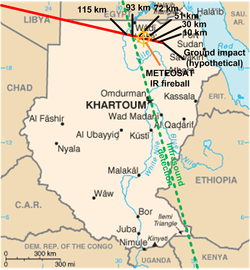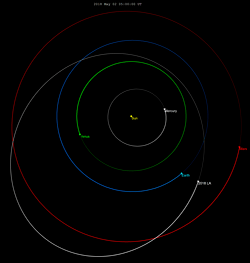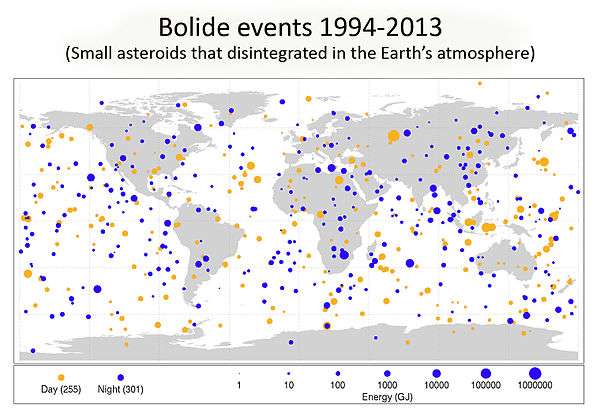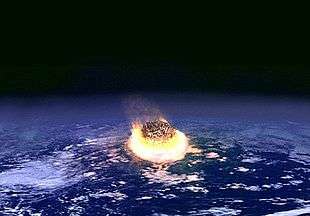Asteroid impact prediction

Asteroid impact prediction is the prediction of the dates and times of asteroids impacting earth, along with the locations at which they will impact. Currently prediction is mainly based on cataloging asteroids years before they are due to impact. This works well for larger asteroids (> 1 km across) as they are easily seen from a long distance, so their orbits can be measured and any future impacts predicted long before they are on their final approach to Earth.
Smaller Near-Earth objects seldom pass close enough to Earth that they become bright enough to observe on a previous approach, and so most can only be observed on final approach. Current mechanisms for detecting asteroids on final approach rely on ground based telescopes. However current telescopes do not monitor the sky often enough to detect most of the smaller asteroids that commonly impact Earth during the short time that they are bright enough, which is why so few are detected.[1]
Sentry prediction system
The International Astronomical Union Minor Planet Center (MPC) is the global clearing house for information on asteroid orbits. NASA's Sentry System continually scans the MPC catalog of known asteroids, analyzing their orbits for any possible future impacts.[2] Currently none are predicted (the single highest probability impact currently listed is ~7m asteroid 2010 RF12, which is due to pass earth in September 2095 with only a 5% predicted chance of impacting).[3][4]
Annual prediction success rates
This section shows the number of successfully predicted impacts each year compared to the number of unpredicted asteroid impacts recorded by infrasound sensors designed to detect detonation of nuclear devices:[5]
|
|
Successfully predicted impacts | Unpredicted impacts |
|---|---|---|
| 2006 | 0 | 37 |
| 2007 | 0 | 23 |
| 2008 | 1 | 34 |
| 2009 | 0 | 32 |
| 2010 | 0 | 34 |
| 2011 | 0 | 30 |
| 2012 | 0 | 35 |
| 2013 | 0 | 24 |
| 2014 | 1 | 33 |
| 2015 | 0 | 43 |
| 2016 | 0 | 32 |
| 2017 | 0 | 29 |
| 2018 | 1 | 30 |
Improving impact prediction
Two separate approaches have been suggested by NASA to improve impact prediction. The first approach uses more powerful ground based telescopes such as the LSST (due to be operational by 2023).[6] This will improve detection, but being ground-based it will only observe part of the sky around Earth. In particular it will have a large blind spot for any asteroids coming from the direction of the Sun.[1]
To solve this issue, the second approach suggested is the use of space based telescopes which can observe a much larger region of the sky around Earth. Although they still can't point directly towards the Sun, they don't have the problem of blue sky to overcome and so can detect asteroids much closer in the sky to the Sun than ground based telescopes. [4] They can also operate 24 hours a day all year round. Finally, telescopes in space have the advantage of being able to use infrared sensors. These are better for detecting asteroids than optical sensors, and can only be used in space as Earth's atmosphere is too warm for ground based telescopes to use this technology. Space based telescopes are more expensive however and tend to have a shorter lifespan. Therefore, Earth based and space based technologies complement each other to an extent.[1]
In 2017 NASA proposed a number of alternative solutions to detect 90% of Near-Earth objects of size 140m or larger over the next few decades, which will also improve detection rates for the smaller objects which impact Earth more often. Several of the proposals use a combination of an improved ground based telescope and a space based telescope such as NEOCAM.[1] However none of these proposals have yet been funded. As this is a global issue, and noting that to date NASA-sponsored surveys have contributed over 95 percent of all near earth object discoveries, in 2018 the Trump administration asked NASA to find international partners to help fund the improvements.[7][4]
List of successfully predicted asteroid impacts
Below is the list of all near-Earth objects which impacted the Earth and were successfully predicted beforehand. This list also includes any objects which have been identified as having greater than 50% chance of impacting in the future, however none of the future impacts have yet been identified.[8] As asteroid detection ability increases it is expected that prediction will become more successful in the future.
| Date of impact |
Date discovered |
Object | Warning period (days) |
Cataloged[note 1] | Size (m) (approximate) |
(H) (abs. mag) |
Velocity (km/s) |
Explosion Altitude (km) |
Impact Energy (kt) |
|---|---|---|---|---|---|---|---|---|---|
| 2008-10-07 | 2008-10-06 | 2008 TC3 | 0.7 | No | 4.1 | 30.4 | 12.8 | 37 | 0.98[9] |
| 2014-01-02 | 2014-01-01 | 2014 AA | 0.8 | No | 2–4 | 30.9 | unknown | unknown | unknown[note 2][10] |
| 2018-06-02 | 2018-06-02 | 2018 LA[note 3] | 0.3 | No | 2.6–3.8 | 30.6 | 17 | 28.7 | 1 [11] |
Notes
- ↑ There are two main strategies for predicting asteroid impacts with Earth, the Cataloging Strategy and the Warning Strategy. The Cataloging Strategy aims to detect all near Earth objects which could at some point in the future impact Earth. Accurate orbit predictions are made which can then anticipate any future impact years in advance. The larger and therefore most dangerous objects are amenable to this strategy as they can be observed from a sufficient distance. The more numerous but less dangerous smaller objects cannot so easily be detected this way as they are fainter and cannot be seen until they are relatively close by. The Warning Strategy aims to detect impactors months or days before they reach Earth (NASA 2017 Update on Enhancing the Search and Characterization of Near Earth Objects)
- ↑ 2014 AA exploded over the mid-Atlantic, far from the nearest infrasound detectors. Although some detections were made, reliable figures are not known
- ↑ 2018 LA was estimated to have an 82% chance of impacting Earth somewhere between the central Pacific ocean and Africa (Impact path). Several reports from South Africa and Botswana confirmed that it did indeed impact in central Africa and additional observations that came in after the impact post-predicted a consistent impact location.
See also
- Impact event
- Asteroid impact avoidance
- List of bolides (asteroids and meteoroids that impacted Earth)
- Earth-grazing fireball
- List of asteroid close approaches to Earth
References
- 1 2 3 4 "Update to Determine the Feasibility of Enhancing the Search and Characterization of NEOs" (PDF). Near-Earth Object Science Definition Team Report 2017. NASA. Retrieved 7 July 2018.
- ↑ How Does NASA Spot a Near-Earth Asteroid? on YouTube
- ↑ "Sentry: Earth Impact Monitoring". Jet Propulsion Laboratory. NASA. Retrieved 25 August 2018.
- 1 2 3 "How NASA hunts the asteroids that could smash into Earth". Vox.com. Vox Media Inc. Retrieved 4 September 2018.
- 1 2 "JPL - Fireball and bolide reports". Jet Propulsion Laboratory. NASA. Retrieved 13 October 2018.
- ↑ "LSST Project Schedule". Retrieved 24 August 2018.
- ↑ "Federal Government Releases National Near-Earth Object Preparedness Plan". Centre for NEO Studies. Interagency Working Group for Detecting and Mitigating the Impact of Earth-Bound Near-Earth Objects. Retrieved 24 August 2018.
- ↑ "Impact Risk Data". Sentry: Earth Impact Monitoring. Jet Propulsion Lab. Retrieved 7 July 2018.
- ↑ Jenniskens, P.; et al. (2009). "The impact and recovery of asteroid 2008 TC3". Nature. 458 (7237): 485–488. Bibcode:2009Natur.458..485J. doi:10.1038/nature07920. PMID 19325630.
- ↑ Farnocchia, Davide; Chesley, Steven R.; Brown, Peter G.; Chodas, Paul W. (1 August 2016). "The trajectory and atmospheric impact of asteroid 2014 AA". Icarus. 274: 327–333. Bibcode:2016Icar..274..327F. doi:10.1016/j.icarus.2016.02.056.
- ↑ "Tiny Asteroid Discovered Saturday Disintegrates Hours Later Over Southern Africa". NASA/JPL. Jet Propulsion Laboratory. Retrieved 4 June 2018.
External links
| Wikimedia Commons has media related to Impact events. |


